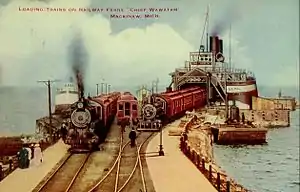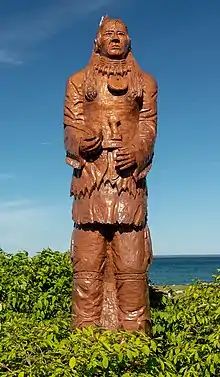SS Chief Wawatam
SS Chief Wawatam was a coal-fired train ferry and icebreaker that operated in the Straits of Mackinac between 1911–1984. Her home port was St. Ignace, Michigan, and she shuttled back and forth during her entire working life between that port and Mackinaw City, Michigan.
 SS Chief Wawatam loading a passenger train at Mackinaw City | |
| History | |
|---|---|
| Name: | SS Chief Wawatam |
| Namesake: | Chief Wawatam |
| Operator: | Mackinac Transportation Company |
| Route: | Mackinaw City to St. Ignace, Michigan |
| Builder: | Toledo Shipbuilding Company |
| Yard number: | Hull number 119 |
| Launched: | August 26, 1911 |
| In service: | October 1911 |
| Out of service: | 1984 |
| Identification: |
|
| Fate: | Cut down to barge in 1989; scrapped 2009 by Purvis Marine |
| General characteristics | |
| Tonnage: | 2,990 tons |
| Length: | 338 ft (103.02 m) |
| Beam: | 62 ft (18.90 m) |
| Installed power: | Six hand-fired, coal-burning steam boilers, |
| Propulsion: | three triple-expansion steam engines, total 4,500 hp (3.36 MW). Three propellors: one forward, two aft |
| Capacity: | 26 freight cars on three tracks |
History
_(cropped).jpg.webp)
Railroad ferry
The Chief Wawatam was designed by Great Lakes marine architect Frank E. Kirby. She was launched in Toledo, Ohio, by the Toledo Shipbuilding Company on 26 August 1911, and went into service for the Mackinac Transportation Company on 18 October 1911. The Mackinac Transportation Company was a joint venture of the Duluth, South Shore and Atlantic Railway, the Grand Rapids and Indiana Railroad, and the Michigan Central Railroad, the three railroads that serviced the Straits of Mackinac.
Year-round train ferry service in the Straits of Mackinac was a significant challenge because of the heavy ice buildup experienced by these straits in winter. The Chief Wawatam was designed to break ice floes with her bow propeller, which could both maneuver the boat and suck water out from underneath the ice to enable it to be broken through force of gravity.

The Chief Wawatam was 338 feet in length and had a beam of 62 feet. Her three propellers, two in the stern and one on the bow, were driven by coal-fired triple-expansion steam engines. The Chief is believed to have been the last hand-fired, coal-burning boat in commercial service on the Great Lakes. Other coal-burning vessels that survived longer in revenue service, such as the SS Badger, had automatic stokers.
The vessel was named after an Ojibwa chief of the 1700s; he was said to have rescued trader Alexander Henry during the Ojibwa uprising at Michilimackinac in 1763. A wooden statue of the chief stands near the harbor in Mackinaw City, Michigan, in Wawatam Park. It was carved by Jerry Prior from a one-hundred-year-old white pine log.
Relics
Need by shippers for the Straits of Mackinac train ferry service provided by the Mackinac Transportation Company declined following construction of the Mackinac Bridge in 1957. After cross-Straits of Mackinac railroad car ferry service ended in 1984, the Chief lay in mothballs for several years in Cheboygan and Mackinaw City. She was towed to Sault Ste. Marie, Ontario, in 1989 and cut down at that port to serve as a barge. In November 2009 it was reported that barge Chief Wawatam was being scrapped.[3] At the time of this final scrappage she was one of the last survivors of the Great Storm of 1913.
One of the Chief's triple-expansion engines was withheld from salvage and, after being restored to operating condition, was placed on display in 2005 at the Wisconsin Maritime Museum in Manitowoc, Wisconsin. Other artifacts from the ferry, including the whistle, wheel, telegraphs, and furniture, are preserved by the Mackinac Island State Park Commission in Mackinaw City.
Legacy
- Wawatam Park, located next to the marina in St. Ignace, Michigan is named for the SS Chief Wawatam and its Odawa namesake.
- Wawatam Lighthouse, a 52 ft (16 m) octagonal structure with lantern and gallery in St. Ignace, Michigan, located at the end of the former railroad ferry pier used by the SS Chief Wawatam.[4]
See also
- Old Mackinac Point Light
- USCGC Mackinaw (WAGB-83)
- Wawatam, the ship's Odawa Indian namesake
- Wawatam Lighthouse
References
- http://www.biographi.ca/en/bio/wawatam_3E.html, WAWATAM, Ojibwa chief at Michilimackinac; fl. 1762–64.
- https://www.mackinawcity.com/history-carved-in-wood/, History Carved in Wood
- Eppley, Jonathan (2009-11-12). "Chief Wawatam Scrapped". St. Ignace News. Retrieved 2009-11-18.
- Rowlett, Russ. "Lighthouses of the United States: Michigan's Eastern Upper Peninsula". The University of North Carolina at Chapel Hill. Retrieved September 18, 2015.
Further reading
- Burgdorf, Frances D. (1976) Chief Wawatam: Story of a Hand Bomber Cheboygan, Michigan 297 pages
- Hilton, George W. (December, 2003) Great Lakes Car Ferries Montevallo Historical Press, Incorporated (240 Pages) ISBN 978-0-9658624-3-1; ISBN 0-9658624-3-7; ISBN 978-0-9658624-3-1
- Zimmermanm, Karl (1993). Lake Michigan’s Railroad Car Ferries. Andover, New Jersey: Andover Junction Publications. pp. 52–63. ISBN 0-944119-11-5.